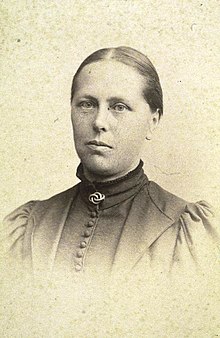Camille Vidart
Camille Vidart (* 14 February 1854 in Divonne-les-Bains ( Pays de Gex ); † 28. June 1930 in Geneva ) was a French - Swiss high school teacher and women's rights activist .
Life
Camille Vidart was the daughter of Alphonse Vidart, a doctor , and Jean-Louise Vaucher. She spent her childhood with an aunt in Geneva. She then trained as a language teacher at the University of Lyon . Vidart taught in Geneva from 1875. From 1880 she was a teacher at the Höhere Töchterschule in Zurich , where she translated Johanna Spyri's " Heidi " into French . From 1884 to 1886 she taught at the Ecole Vinet in Lausanne.
On her return to Geneva, Vidart joined the Fédération abolitionniste Internationale . In 1891 she joined the progressive Union des femmes de Genève , was elected Vice-President in 1892 and served as President from 1898 to 1902. In 1896 she organized the 1st Congress for Women's Interests, which took place on the occasion of the National Exhibition in Geneva. In the following years, Vidart worked hard to merge the Swiss women's associations into one umbrella organization . Together with the presidents of the progressive women's organizations in German and French-speaking Switzerland , she took the initiative in 1899 to found the Federation of Swiss Women's Associations. Until 1908 Vidart worked on its board . From 1899 to 1904 she was also secretary of the International Women's Federation .
As a pioneer in the fight for political equality , Vidart was involved in the World Federation for women's suffrage at an early stage . In 1907 she founded the Association genevoise pour le suffrage féminin with August de Morsier and in 1909 she participated in the founding of the Swiss Association for Women's Suffrage . After the outbreak of World War I , she joined the Women's World Association for the Promotion of International Unity and the International Women's League for Peace and Freedom as a staunch pacifist . In addition to her feminist activities, Vidart opened a restaurant for female workers and an office for proof of work in 1910 . She always fought for social justice and worked for various social reform magazines .
literature
- Emilie Fatio-Naville Camille Vidart. In: Yearbook of Swiss Women, 1930/1931, pp. 7–24.
- Service pour la promotion de l'égalité entre homme et femme: Pionnières et créatrices en Suisse romande XIXe et XXe siècles. Slatkine, Genève 2004, pp. 390-394.
Web links
- Regula Ludi: Camille Vidart. In: Historical Lexicon of Switzerland . April 30, 2015 , accessed August 8, 2020 .
- Entry on Camille Vidat in the Swiss elite of the 20th century
|
|
This version of the article is based on the entry in the Historical Lexicon of Switzerland (HLS), which, according to theHLS's usage instructions, is under the Creative Commons license - Attribution - Distribution under the same conditions 4.0 International (CC BY-SA 4.0). If the article has been revised and expanded to such an extent that it differs significantly from the HLS article, this module will be removed. The original text and a reference to the license can also be found in the version history of the article. |
| personal data | |
|---|---|
| SURNAME | Vidart, Camille |
| BRIEF DESCRIPTION | French-Swiss high school teacher and women's rights activist |
| DATE OF BIRTH | February 14, 1854 |
| PLACE OF BIRTH | Divonne-les-Bains |
| DATE OF DEATH | June 28, 1930 |
| Place of death | Geneva |
